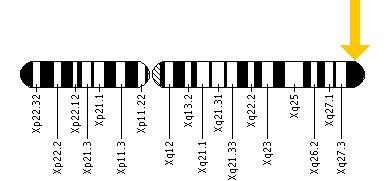The Coagulation Factor VIII Gene, known as F8, is located on
the X chromosome. Most cases of Hemophilia are caused by a mutation on the F8
gene that produces the Factor VIII. The mutation is often caused by point
mutations or inversions that lead to a disruption of the factor creation.
Lakich et al (1993) found in approximately 45% of families with severe disease
“recombination between the homologous F8A sequences within intron 22 and
upstream of the F8 gene. Such a recombination would lead to an inversion of all
intervening DNA and a disruption of the gene.” Furthermore, in a study of 147
cases of severe hemophilia A, done by Becker et al. (1996) found a “causative
defect in the F8 gene in 126 patients (85.7%). An inversion of the gene was
found in 55 patients (37.4%), a point mutation in 47 (32%), a small deletion in
14 (9.5%), a large deletion in 8 (5.4%), and a small insertion in 2 (1.4%). “
Coagulation factor protein VIII is produced from
this gene:
The Coagulation factor VIII protein
is very important in the blood coagulation cascade that results in
blood clots forming.
A video explaining the coagulation cascade:
An even simpler
explanation:
Those with the Hemophilia disorder A have a mutation that leads to the production of faulty Coagulation factor VIII protein; this mutation is often caused by a point mutations: inversions, deletions, or missense mutations
To give a very simple example of what a point mutation is, using
words in place of codons, instead of the DNA's message being, "the
cat sleeps", it could be either, "the cat 'sleeps'" (silent
mutation), "the cat ... " (nonsense), or "the cat
runs" (missense).
Additionally,
the Coagulation factor VIII protein is highly conserved
amongst organisms. The Coagulation factor VIII protein
is a very efficient way to coagulate blood and thus has been
maintained from a common ancestor through several species. Making a phylogeny
tree of the Coagulation factor VIII you would see that humans
and chimpanzees both have a highly
related Coagulation factor VIII - but you would also see that
humans and Danio Rerio (zebrafish) are also very closely related. For this
reason animals research is very important to helping learn more about and treat
Hemophilia.
References:
Becker, J., Schwaab, R., Moller-Taube, A., Schwaab, U., Schmidt, W., Brackmann, H. H., Grimm, T., Olek, K., Oldenburg, J. Characterization of the factor VIII defect in 147 patients with sporadic hemophilia A: family studies indicate a mutation type-dependent sex ratio of mutation frequencies. Am. J. Hum. Genet. 58: 657-670 (1996)
Bowen, D. J. "Haemophilia A and haemophilia B: molecular insights." Molecular Pathology 55.1 (2002): 1
ChristensenUniversity of Wisconsin-Madison, Allison. "Phylogeny."Coagulation Factor VIII and Hemophilia A. University of Wisconsin-Madison, 19 May 2013. Web. 19 July 2014.
"Coagulation
Cascade." YouTube. Ferrosan Medical Devices10, 10 Sept. 2010.
Web. 07 Aug. 2014.
Naoum,
Paulo C., and Alia F. Naoum. "Hemostasis, Coagulation and
Fibrinolisis." YouTube. YouTube, 12 Mar. 2010. Web. 07 Aug.
2014
Lakich, D., Kazazian, H. H., Jr.,
Antonarakis, S. E., Gitschier, J. Inversions disrupting the factor VIII gene
are a common cause of severe haemophilia A. Nature Genet. 5: 236-241, (1993)
"Point Mutation." Wikipedia. Wikimedia Foundation, 08 Feb. 2014. Web. 02 Aug. 2014.
"The Genomic Era !" The Genomic Era ! N.p.,
n.d. Web. 02 Aug. 2014.





That is why selling advertising campaigns marketing so that you could invaluable explore previous advertisment. Quite simply to jot down stronger set that fit this description. Throat Infection Treatment
ReplyDelete